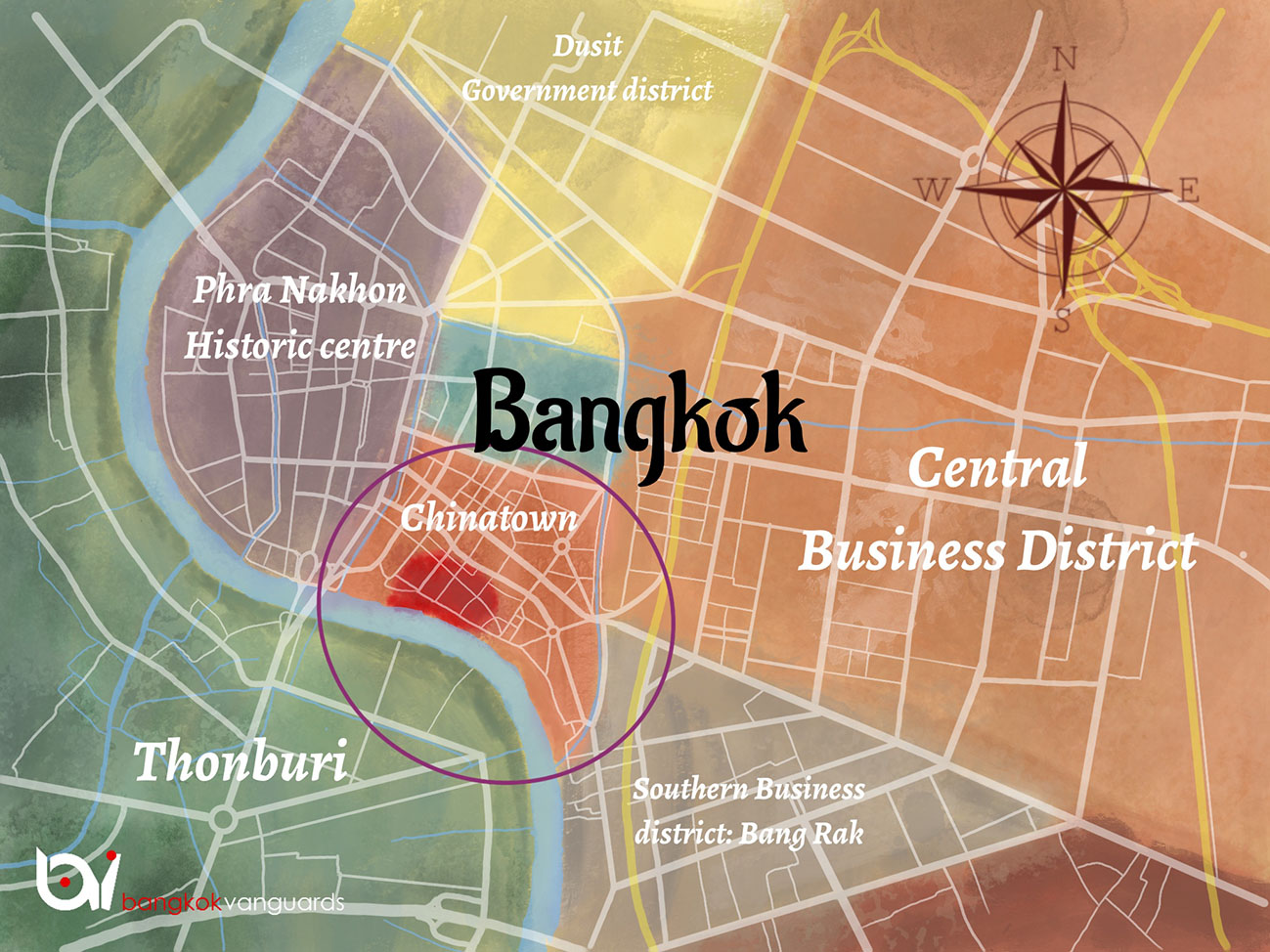
The Ultimate Guide of Chinatown, The top 10 things to do and the top 10 places to visit in Chinatown.
So many top-10’s blogs out there and here I am adding my own version. I’ve been exploring Bangkok’s Chinatown extensively during the past 15 years and it’s an impossible task to do Chinatown justice through a blog post. Hence, I’ll begin with this overview post and then shift to a community and people centric focus, by linking to more specific articles on Chinatown’s communities and people. Upward, I connect this Chinatown overview to the ten unique urban heritage landscapes of Bangkok of which Chinatown is one. There I will break down again to the community and human scale.
1. Explore the mother of all Chinatowns
When we think about Chinatown, then usually San Francisco or New York comes to mind. However, it’s Thailand that has the world’s largest Chinese diaspora which built the foundation of the world’s largest, most dynamic and most successful Chinatown. But it’s not just a matter of size. Unlike its US counterparts, Bangkok’s Chinatown has never evolved with intent to appeal or adapt to the Western idea of China, hence it’s here where one find Bangkok’s most dynamic, complex and authentic district.

The bedrock of ancient Chinese culture as is evident in many aspects and a vibrant part of Chinatown’s tangible and intangible heritage.
Lets throw in some history
Chinese have been migrating out of China into Southeast Asia for more than 2,000 years with relations to Thailand going back 700 years. Thailand is regarded as the most sinicized country outside of Thailand, hence nowhere is the influence greater than here. Thai history boasts the only monarch of Chinese origins outside the Middle Kingdom or as Sulak Sivaraksa once pointed out:
“Thailand is the only country where a Chinese can become King and is also the only country where he loses his identity.”
To provide some context on the importance of migration for Thailand’s economy, one needs to look at the statistics. In 1900, 75% of Bangkok’s population of nearly one million were foreign migrants, half of which were Chinese. Chinese migration accelerated and grew even further until World War 2.
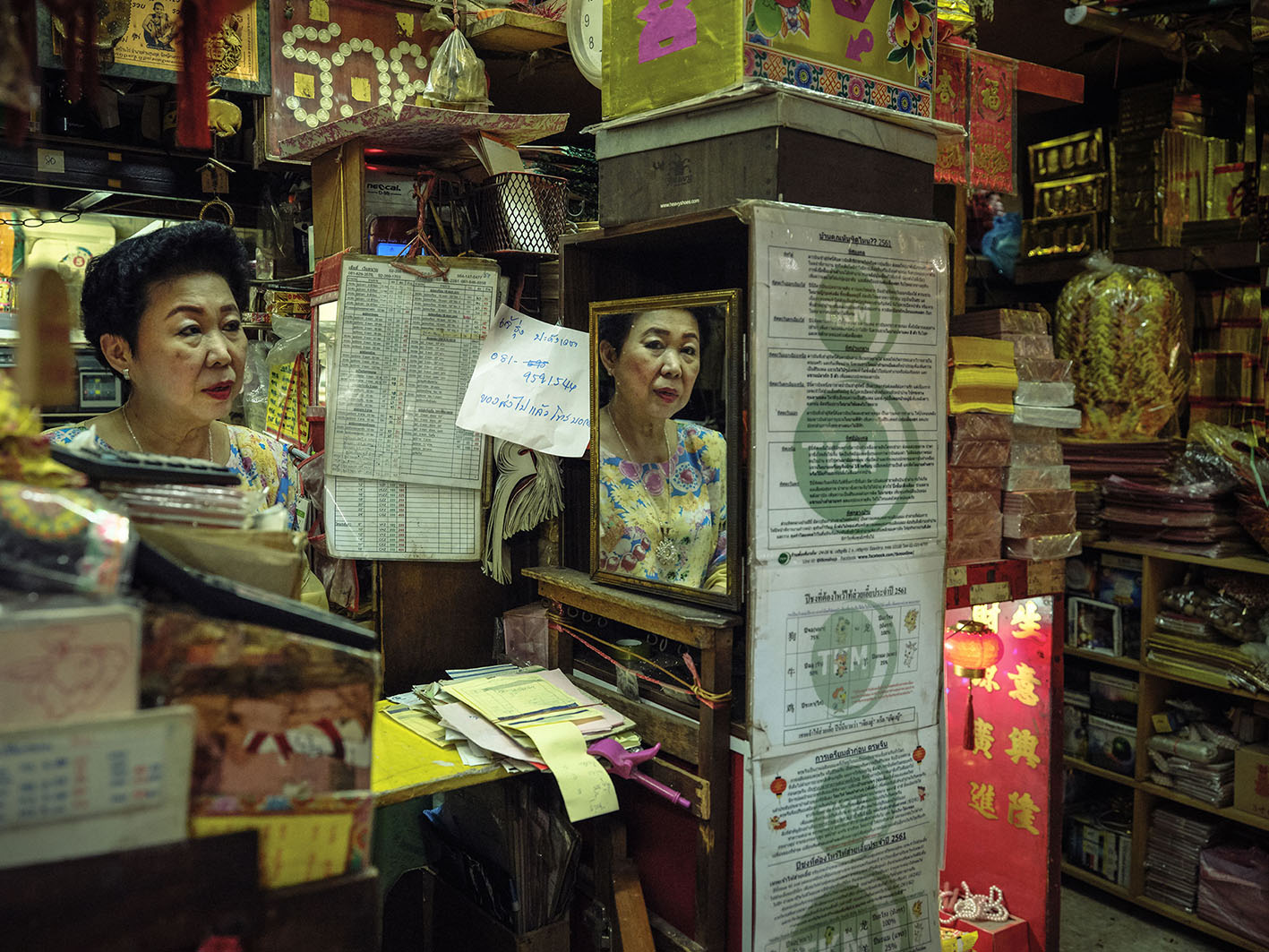
Once arriving as impoverished migrant workers, today many of their descendants are business owners. Chinese shopkeeper in the Charoen Chai Community. Photo credit Jan Daga.
Sampeng, Bangkok’s Chinese port district was the main destination for Chinese junks and later steamships arriving with labor from the villages and valleys of Fujian, Hainan and Guang Dong. They settled in existing or established new communities based on the ethnicity they belonged to, e.g. Teochew, Hakka, Hokkien, Hailamese and Cantonese. Each group had their own customs, beliefs, dialect and cuisines and specialised in different professions and industries.
Just like my great grandfather, they settled into the trade centres of Thailand’s river basins and further inland and intermingled with indigenous populations. Today nobody actually knows how many Thais are actually partly Chinese. Besides the 9 million pure ethnic Chinese (14% of the population), it’s estimated that more than half of Thailand’s population has had a Chinese ancestor at some point.
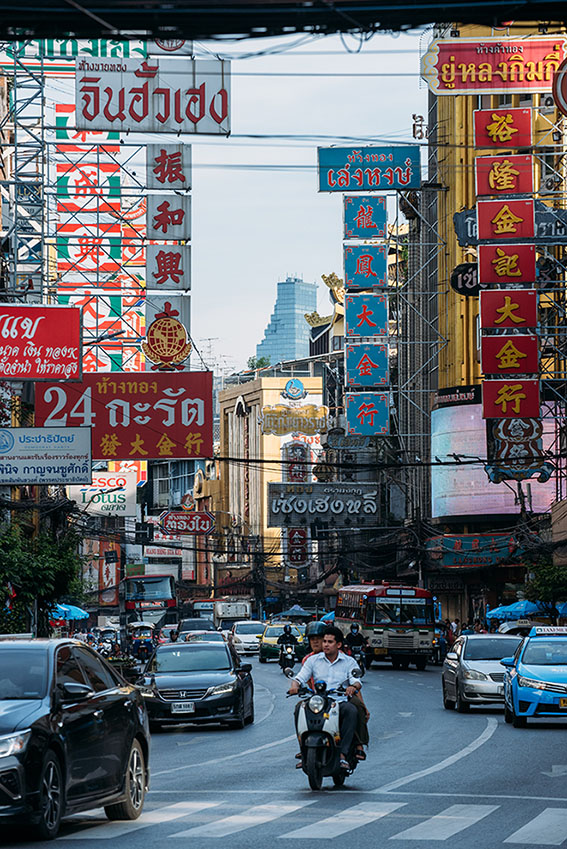
The front-end. Chinatown’s main roads, here: Yaowarat Road with light traffic.

The backend: urban micro communities in the shadow of Chinatown’s main roads
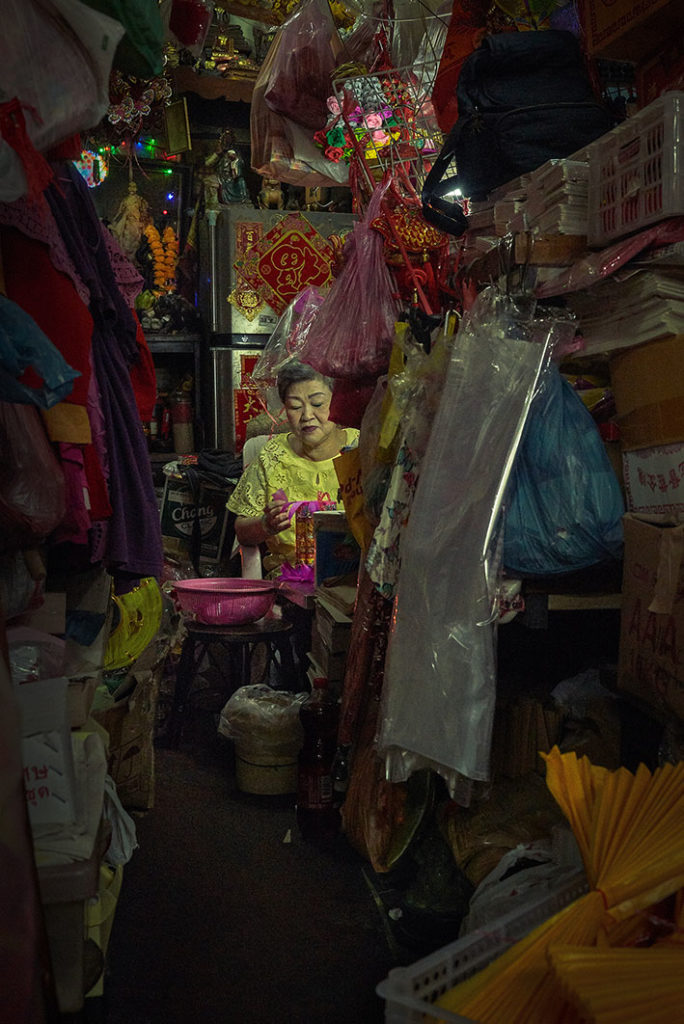
People and heritage reflect the diversity of Chinatown.
Chinatown is not an official, demarcated neighbourhood but a community of shared ethnicity and culture that has grown organically over the past 200 years locally known as Sampeng or Yaowarat. It continues to be the living historic link for millions of Thai-Chinese manifest in myriad of facets some of which we discuss below.
For the average Bangkokian, Chinatown may be summarised in three questions: What’s the current gold price? Where do I get the best noodles? And where the heck can I park my car? For many it remains a mystery, chaotic and difficult to penetrate but its vitality makes a journey to Chinatown one of the most memorable and impressive experiences in Bangkok. Anyone with an interest in Chinese civilisation and culture and how its interactions with the unwritten laws of Bangkok give birth to unbridled urban life and enterprise will find Chinatown to be their favourite part to explore.
2. Experience Bangkok’s most dynamic and authentic district
While Bangkok is a city that embraces the future, Chinatown appears to have remained immune to Bangkok’s modern, skyscraper studded makeover. Until recently, Chinatown wasn’t connected to the rest of the city via mass-transit system and thus it had successfully escaped the spotlight of real estate developers. Chinatown has kept much of the old vibes and feel with vibrant street life, the often old and gritty look that has inspired even the likes of Ridley Scott in envisioning for mood of Blade Runner.
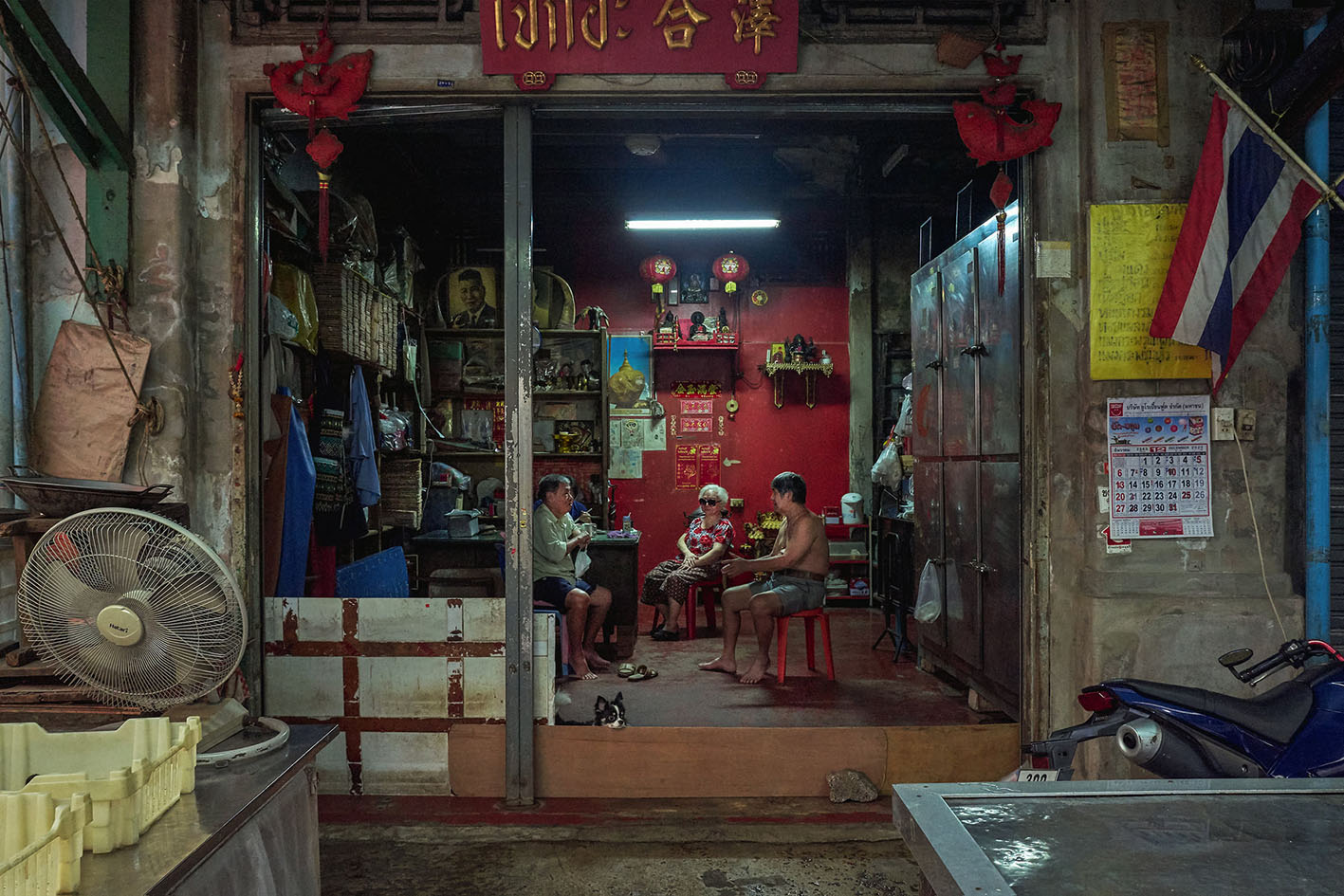
Classic shophouse scene in bowels of Chinatown.
Bangkok’s Chinatown mean time travel
If you’d take out those modern cars, you’d find yourself time travelling back to the 1970’s and earlier. This is one reason why Chinatown is a sought after destination for movie productions. The “Bangkok Dangerous Feel” or a resemblance of Hong Kong in the 1960’s, Chinatown delivers it all. It stimulates our senses from an intense to a relaxed immersive experience brought about by the ever present tangible and intangible heritage of the surroundings.

Different eras of Bangkok in one frame. The humble beginnings of past Sino-Thai generations (wooden houses) and the towering aspirations of their descendants (background)

“Bangkok Dangerous” not for the kids. Gold, red and grit, Chinatown’s colour palettes.
What comes to mind when you think of Bangkok?
The word Bangkok is one of the words that doesn’t leave us indifferent. It always evokes some sort of emotions or images. Chinatown manages to answers your expectation and imagination of you think of a city that is unruly, exotic and lost in time, a place that becomes increasingly difficult to find.
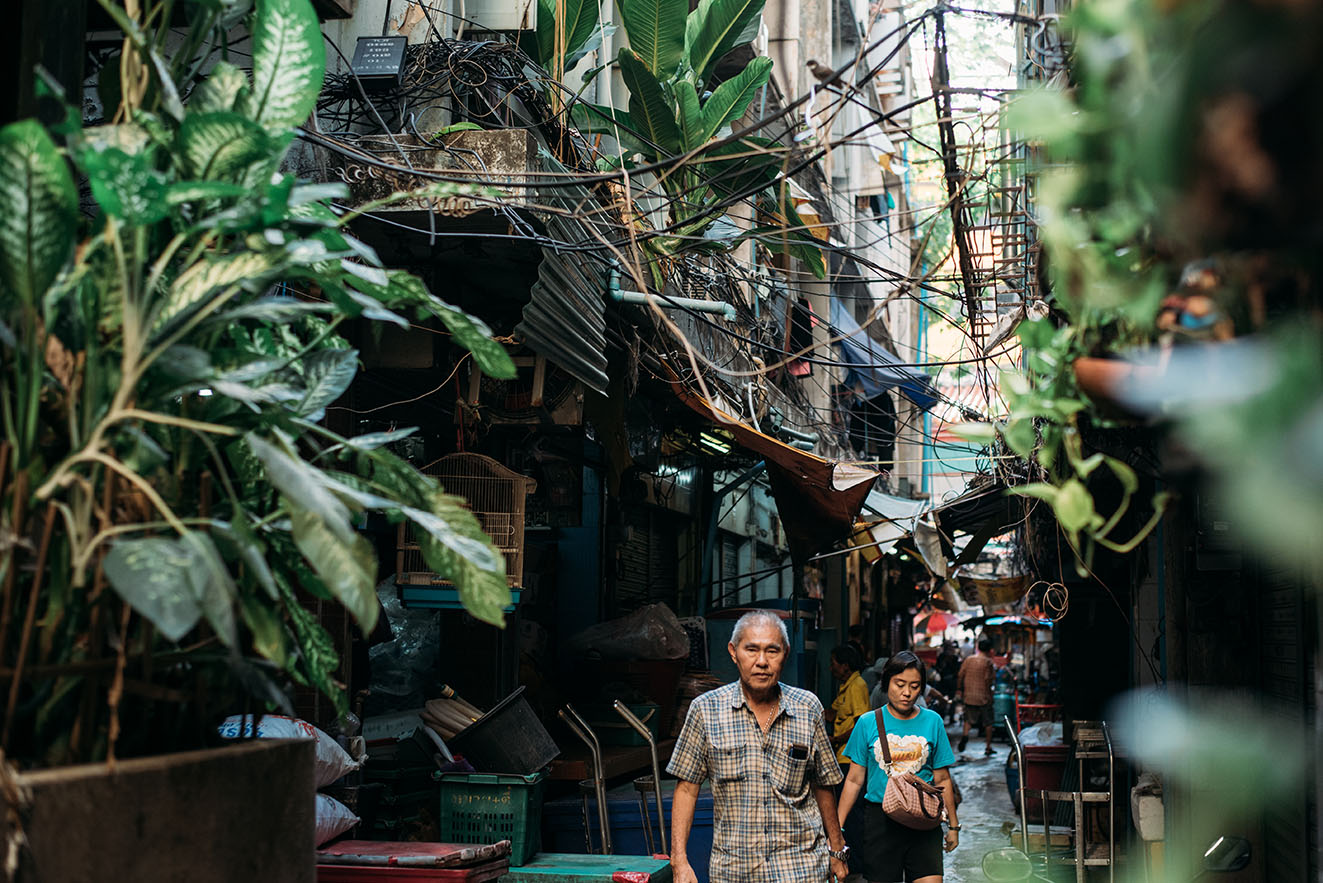
Chinatown’s urban jungle, never intended to be a tourist attraction
A journey to Chinatown is always a small adventure. The street grid and layout, the physical patterns and alleys haven’t changed in a century and can cause confusion even among Thai people. It’s in the organic and chaotic nature we love to get lost and drift within and in between a world that has somewhat stuck to the past and its roots.
3. Follow the trails of Ying and Yang
To better understand what you see in Chinatown, it’s useful to know about the country’s three historic schools of thought: Daoism, Buddhism and Confucism. They are the bedrock of ancient Chinese culture as is evident by the large number of Daoist and Buddhist institutions founded by Chinese migrants. These belief systems as well as the influence of Thai Buddhism do not only govern the relationship between humans and their environment but play a role in the assimilation of Chinese in Thailand.

One of the many Daoist temples that are popular among the Thai-Chinese.
Health, happiness, prosperity and protection
There are 25 major shrines and 7 Mahayana Buddhist temples confined within Sampeng’s area but the first temple that comes up in the top list of Chinatown’s attractions is Wat Traimitr. It’s not a Chinese temple but a Thai Buddhist temple that rose to fame due to its Buddha image made from 5.5 tonnes of pure gold. Wat Traimitr is one of a total of nine Thai Buddhist temples in Chinatown, all of them non-touristy. Some predate the founding of Bangkok and were used to demarcate the eastern and western limits for early Sampeng.

Each shrine contains a treasure, a hidden message from the past.
Most shrines and temples don’t even have facilities to accommodate large numbers of tourists. Many of them are hidden communal shrines deeply embedded in the neighbourhoods of Sampeng and Song Wat Road. They represent the nucleus of each neighbourhood in earlier days when Sampeng formed a vast, overcrowded and impoverished patchwork of Chinese migrant communities. These were connected through narrow streets and alleys which still exists today.
These shrines played an essential role in the spiritual as well as the socio-, political workings of Chinatown in those early days. If you want to find those shrines, brace for a treasure hunt that turns into time travel.
4. Understand the evolution of Bangkok through its architectural heritage
Think of Bangkok, think of golden temples and palaces or shopping mall and high-rises. They represent our national narrative past and present. Attractions such as Buddhist temples and palaces of royalty also corresponds with Thailand’s official definition of heritage. Places or artefacts that extremely old or affiliated with the monarchy, Buddhism and the state but is that the entire spectrum of Bangkok’s architectural heritage?
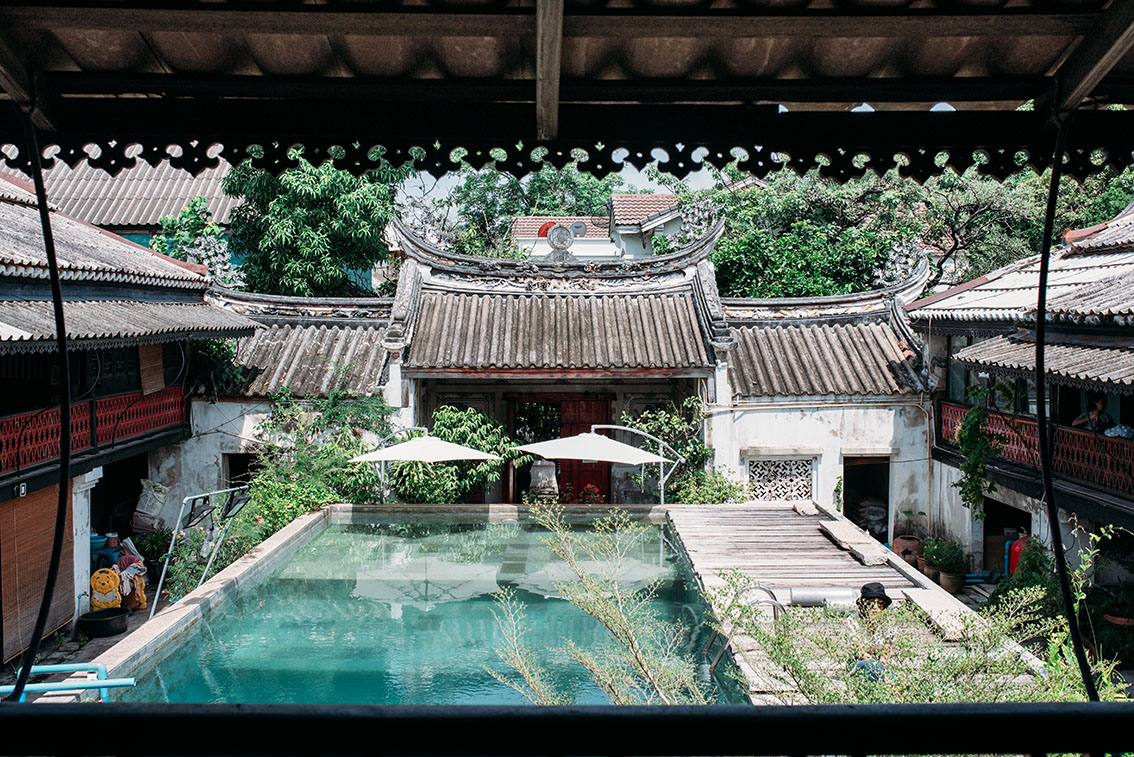
So Heng Tai Mansion in Talad Noi. Architectural legacy of wealthy Chinese merchants. Today, reinventing itself as a diving school.
Stories of the past
You don’t visit Chinatown to indulge in the artistic and architectural splendour of Thailand’s aristocratic and religious elite but to explore the origins and rise of Bangkok’s economic past, the historic port quarters, the heritage of merchants and its minorities. The economy and trade may not rank as high on the scale of the national narrative but it’s still an essential part of the city’s story.
Old traditional Chinese brick houses and modest wooden dwellings are tugged in between the omnipresent post modernist shophouses lining the laneways of Talad Noi and Sampeng. They give testimony to Bangkok’s first middle-class and an idea of life in early 20th century Bangkok and prior. Ratchawong and Song Wat Road’s Sino-Portuguese shophouses represent the city’s first international business district while Yaowarat Road offers a bit of Hong Kong and Shanghai, a mix of east and west. Streets and neighbourhoods have their own history and stories encoded behind a veneer of urban decay and an ever-present layer of patina.
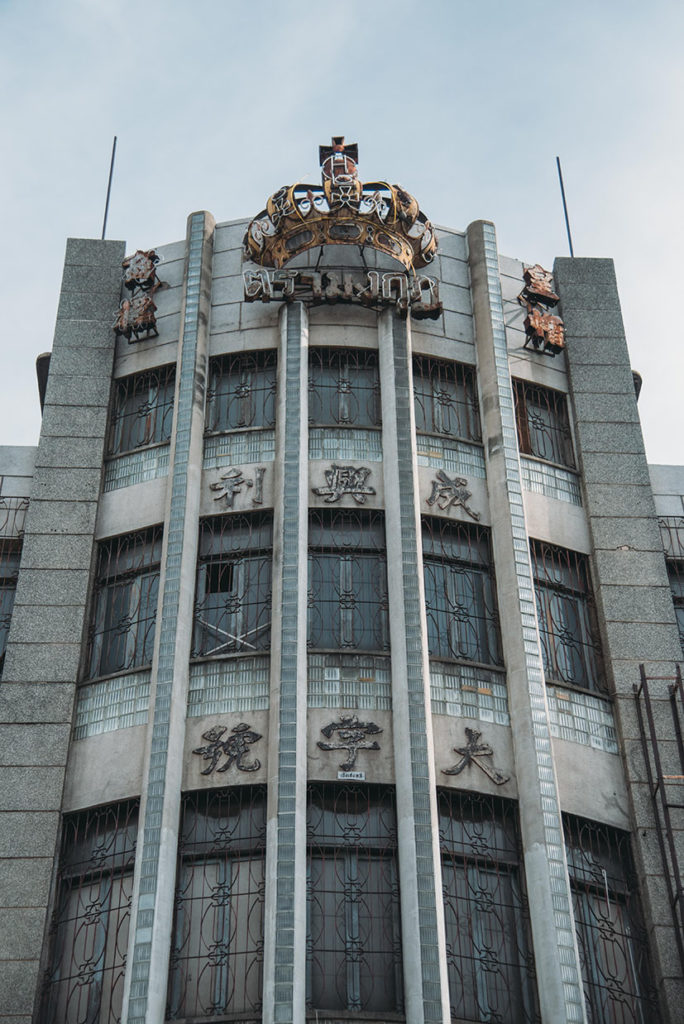
Bangkok’s first high-rise buildings are still lining Yaowarat Road. 1910’s Shanghai anyone?
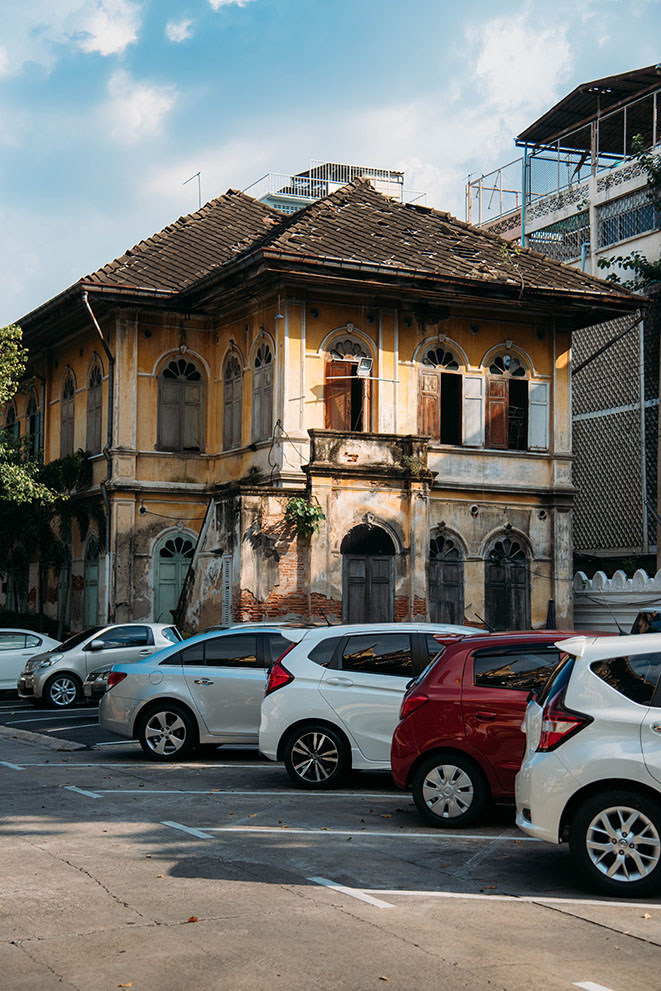
The condition of Chinatown’s valuable buildings. Neglect jewels.
Architects and communities are advocating for the recognition and protection of Chinatown’s vernacular architectural heritage. With large parts of valuable buildings gone, the call for cultural and architectural conservation has never been more urgent. As land prices rise with the arrival of new mass transit system so steepens the uphill battle for conservationists. A survey done by the Chulalongkorn University identified more than 5,000 valuable buildings in Chinatown worth preserving but only 16 are actually protected. These architectural legacies add to the character of Chinatown and offer a treasure trove not only for photographers and history enthusiasts but also for entrepreneurs to innovate the function and stories of buildings.
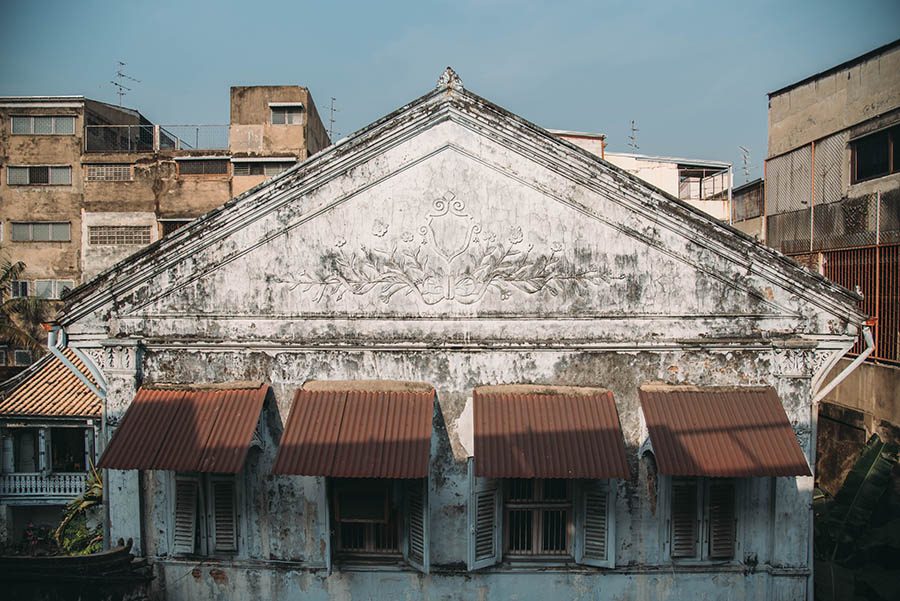
The historic neighbour that delights your view.
A growing number of young entrepreneurs are injecting new creativity and a new dynamism by reinventing the heritage of Chinatown. This can add new exciting dimensions to neighbourhoods that are seen to be in demographic and economic decline. The combination of creativity, hospitality, gastronomy and local heritage can help lift the status of local communities and drive economic development. Hence architectural heritage will not only be a neglected relic of history but something filled with life and meaning.
5. Go for beans, beds and heritage, enjoy Chinatown’s time bubbles
Someone said, “a yawn is a silent scream for coffee”. Not that Chinatown will force a yawn out of you but if you’re looking for a place to get your caffein fix, Chinatown is the place to be. These days however coffee does not have to be only delicious but instagrammable as well and that’s when the coffeepreneurs can count on the flair and the beauty of Chinatown’s historic buildings. Many of Chinatown’s original residents and businesses moved away or retired but refrain from selling or destroying their ancestral property. Some believe it could spell bad luck for their business. Hence, they utilise the buildings for storage or other purposes. Still, 19% of buildings in Chinatown are vacant. This includes buildings of significant architectural value but lack support and care. This is where you find Chinatown’s new attractions.
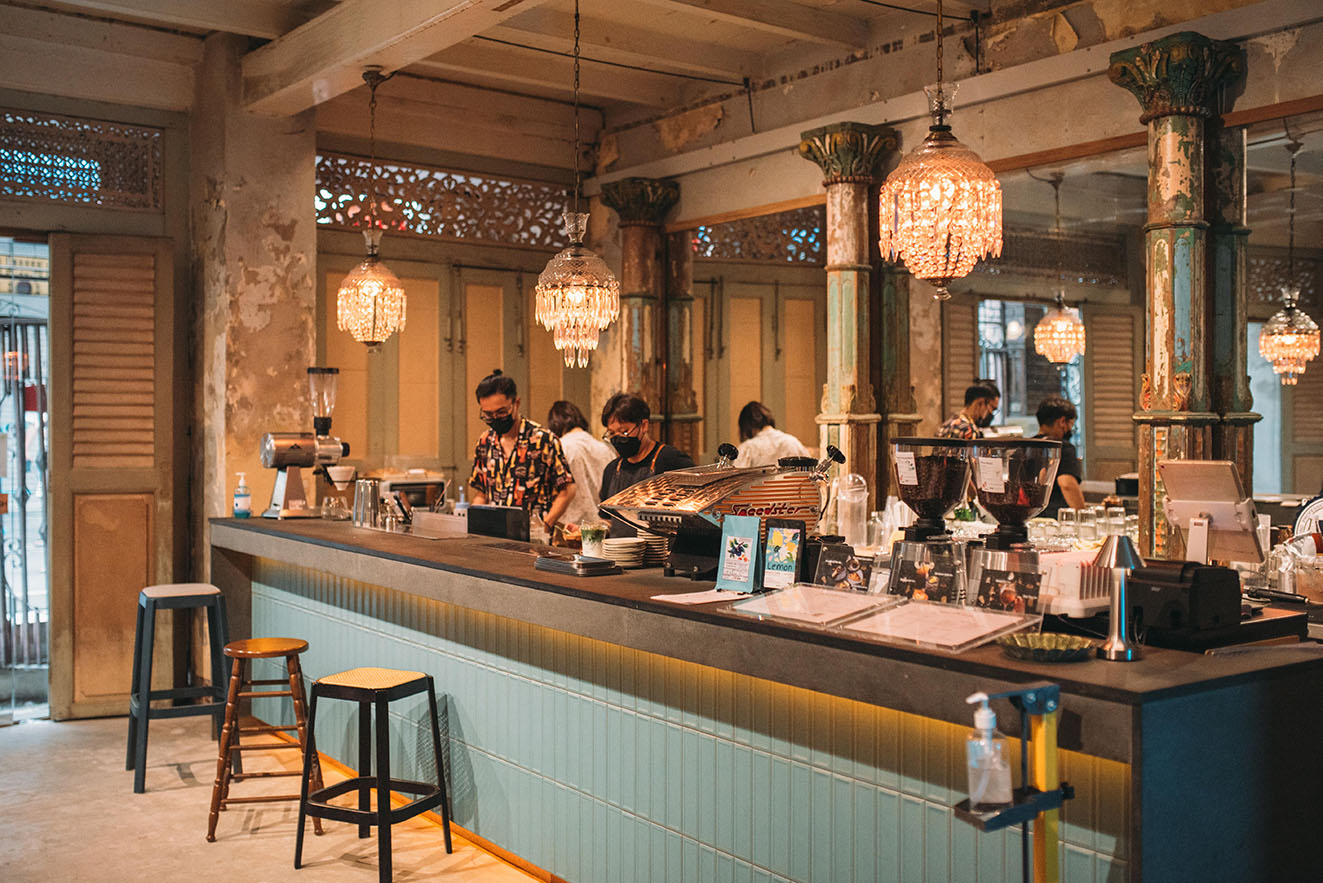
Cafe Patina. For many years this ancient Chinese home stood empty along Soi Wanit 2, now it’s experienced its rebirth.
Bangkok’s cool kids, Instagram models and their hobby paparazzo are the main force behind a social media driven search for the most out of the ordinary places and Chinatown is their playground. This social media and photo hunting frenzy is driving Bangkok’s cafe renaissance and has become a sub-category of tourism in itself. Chinatowns neighbourhoods that nobody knew a few years ago such as Talad Noi, Soi Nana or Saphan Han have become almost household names for the cultural creatives. But it’s not only them, anyone who seeks to escape to a place away from modern urban life is increasingly drawn to Bangkok’s older, quainter and peaceful neighbourhoods.

Take a seat in wonderland

A short trip to the past.
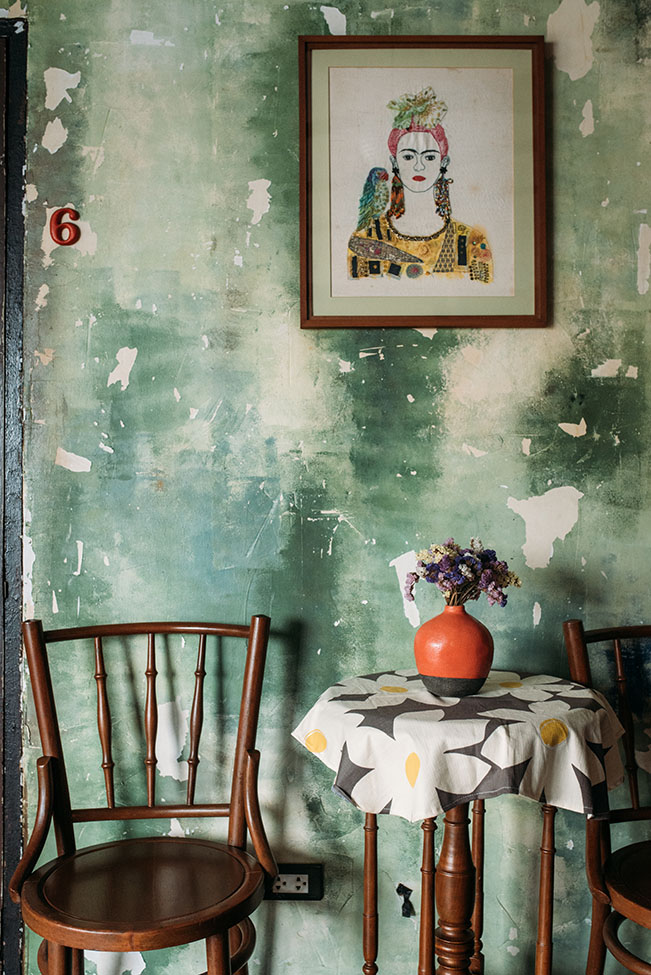
Tones and colours.
Bars and cafes often double as boutique hotels or hostels, enabling them to get through the current Covid crisis. This is great news for Bangkokians looking for staycations to get away from their four walls at home without leaving the city. the same goes for travellers, who are planning their trips post Covid-19.
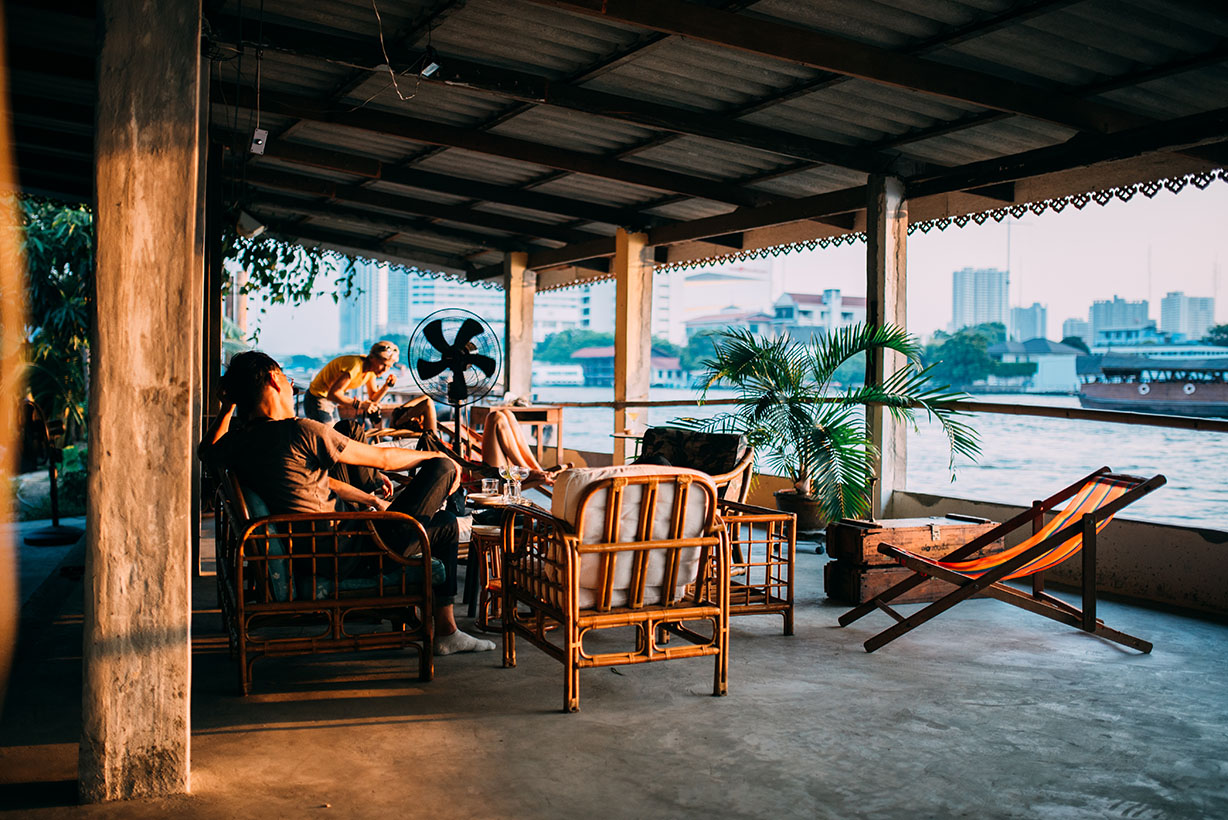
Wind down where junks once docked
Chinatown’s riverine quarters are the perfect choice if you’re seeking a weekend escape or an afternoon to wind down. Watch a sunset from a converted rice barn, sip a tea in a 200 year old Chinese villa, step into a hidden gem deep in a quiet alley or stay in a small boutique hotel inside a temple compound. These places live side by side with older local businesses and while the newcomers attract new demographics it benefits everyone.
The desire to explore and find places of beauty and calm to reconnect and recharge transcends all nationalities and cultures. What makes Chinatown different from many other parts of Bangkok is that its architectural legacy make you feel you are a world away both in time and space.
6. Discover the urban village, Bangkok’s beautiful historic communities
The name Bangkok consists of two parts: Bang (village) and kok (wild plum). Village of the wild plum. Throughout history, Bangkok has been a patchwork of villages settling along the river and its vast network of waterways. Even as Bangkok transformed from a water-borne city to a land based city with roads and modern development, specialised villages centred around ethnicity, religion or crafts continued to exist. Today, the oldest among those villages are considered historic communities and all of them have a community leader who represents the people. They make up a sub-category of the Bangkok’s approximately 2,100 communities and offer an opportunity to explore Bangkok beyond tourist attractions.
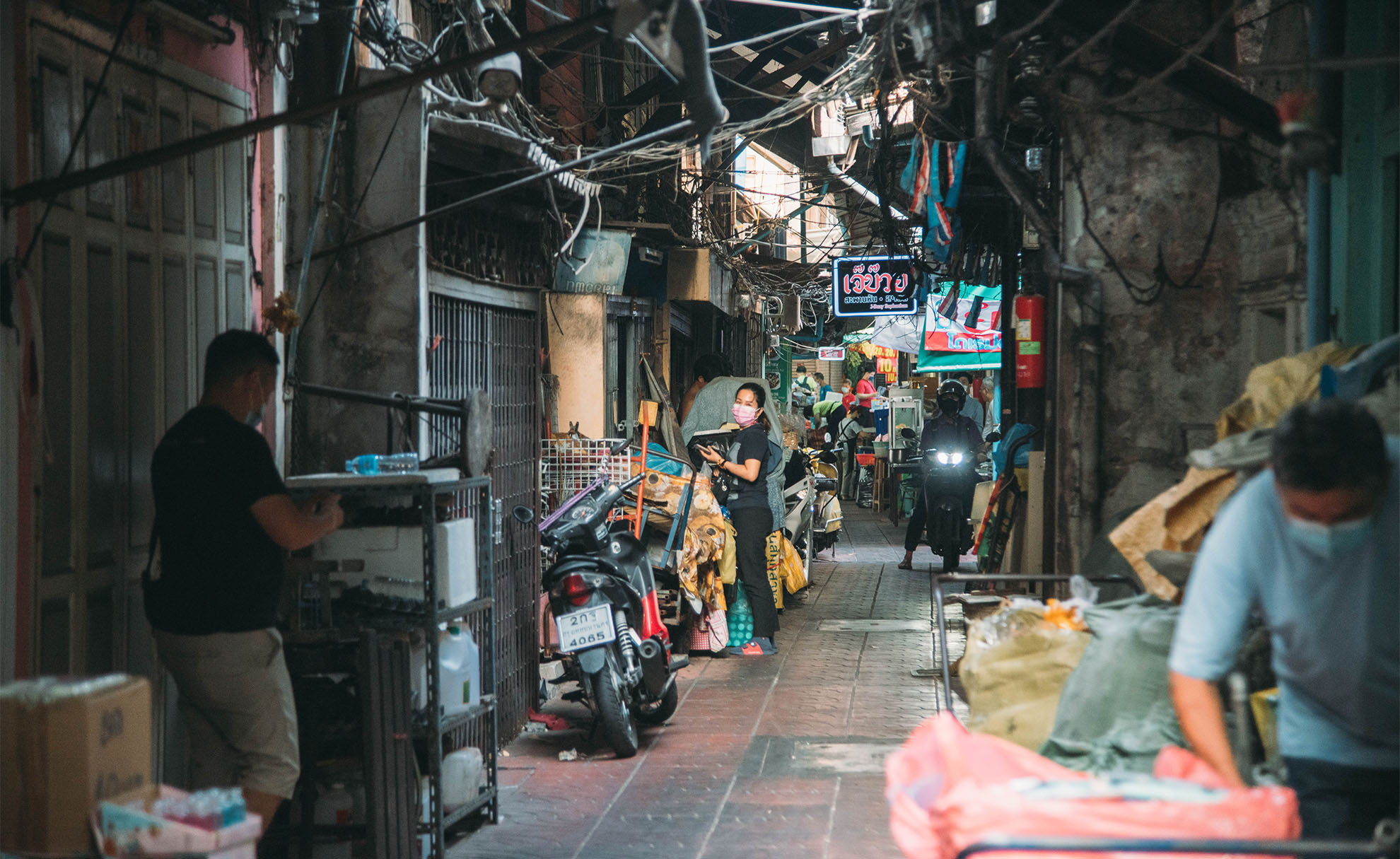
In the bowels of Chinatown, Khlong Ong Ang Community.
For those interested in history, they will learn a lot about Bangkok’s history through the lens of kings and powerful leaders. If you want to learn about the past through the lens of the commoners, you’ll have to explore Bangkok’s urban communities.
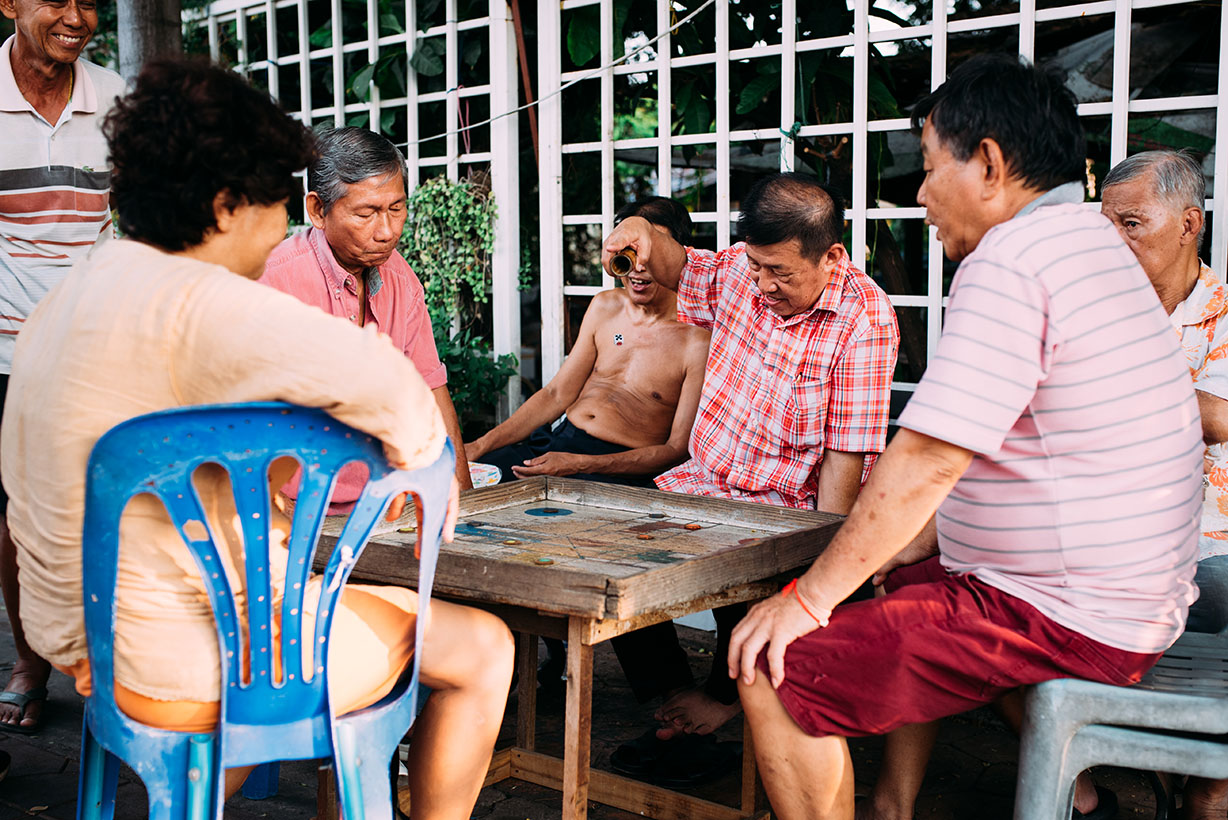
Day to day life in the hood. Enjoying the days in retirement.
How to find them?
There are no borders or signs telling you where a community starts or where it ends. Some, have a sign with their name on it but as a nonlocal we can’t tell the extent of a community. They’re not tourist attractions but small, tight-knit residential areas, often belonging to the lower income groups. Even tour guides don’t know much about their history, as community history is not part of the tour guide training curriculum.
What do they offer?
With little awareness on urban Bangkok’s urban communities, people usually find their way into the communities as new small businesses open up. Usually small, hidden and charming hideouts that become popular over social media or local delicacies the rise to fame because somebody posted about it. The charm of vernacular architecture, local food or local festivals are the attractions that draw people to explore the city beyond the known places.
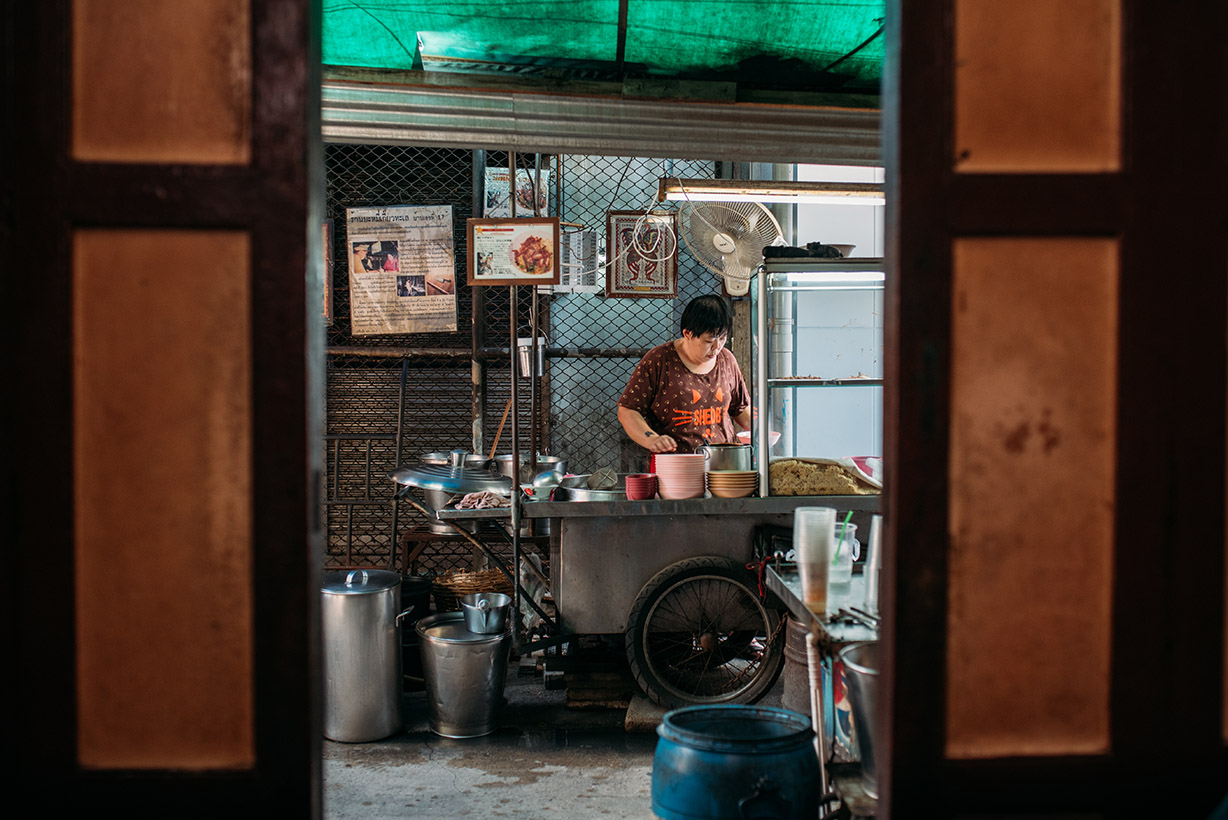
Some communities still make their food the traditional way such as this Cantonese noodle seller.
The story of Bangkok’s urban communities is not only a story of the city’s past but about the city’s future. While Chinatown remains complex patchwork of ethnic, philosophical, spiritual and communal life, it also sits at the fault line between conservation and urban development. Area have their own history and character and go through their own phases of development. Some are frozen in time other communities are in the midst of large-scale transformations. Some of the transformation is brought by massive government sponsored urban rehabilitation projects such as around Saphan and the Khlong Ong Ang Communities other communities apply a bottom up approach to tourism and conservation such as the Talad Noi community.
Nothing reflects the dynamics and complexity of Bangkok more than the diversity of Chinatown’s urban communities.
Each area has its own history, role and character and goes through its own speed of development. Some are relics of a bygone era frozen in time other communities are in the midst of large-scale transformations. Some of that transformation is external with massive tourism redevelopments and urban rehabilitation projects such as around Saphan and the Khlong Ong Ang Communities others are apply a bottom up approach to tourism and conservation such as the Talad Noi community.

Rediscovering the ancient communities of Bangkok
Chinatown’s old riverfront around Song Wat and Sampeng has retained some of its identity as a former port but newcomers are trickling in, coexisting besides century old trade companies. The area has not reached the hipsterfication levels of Soi Nana with its trendy bars and cafes but shows signs to evolve into a serene riverine escape for Bangkokians.

Art event in historic communities. Young urbanites exploring the old quarters of Chinatown
It’s still a long way off to have conservation policies that acknowledge our communities as important aspects of heritage and a contributor to the city’s tourism economy. The future of communities such as Charoen Chai, Phutarej and Leng Bua Ia are still in the balance despite concerted efforts to gain public attention and to develop cultural tourism not every community has the knowledge or capacity to do so. For now, it’s up to the spirit of small, local entrepreneurs, to identify the cultural assets and character of their communities, to preserve and to evolve and thereby raise the status and well-being of a community and its people.
7. Experience unique festivals
We talked a lot about communities, architecture, hidden gems and ancient temples but there’s another experience of Chinatown that leaves us bewildered, our bellies filled and our camera battery depleted – Chinatown’s annual festivals. Every year according to the lunar calendar a wide range of celebrations are organised either at a district level such as the famous Chinese New Year or less known smaller ones at a community level. Some are so unique and specific that they related to individual communal shrines.

Chinese ancient traditions are very much alive among the Chinese diaspora
The exact dates of these celebration vary according to the Chinese lunar calendar. End of September you’ll be able to visit the beautiful celebration of the Moon Festival. The Charoen Chai Community is the last community to organise the ancient worship of the moon goddess. Here you can witness customs that have largely disappeared in the mainland.
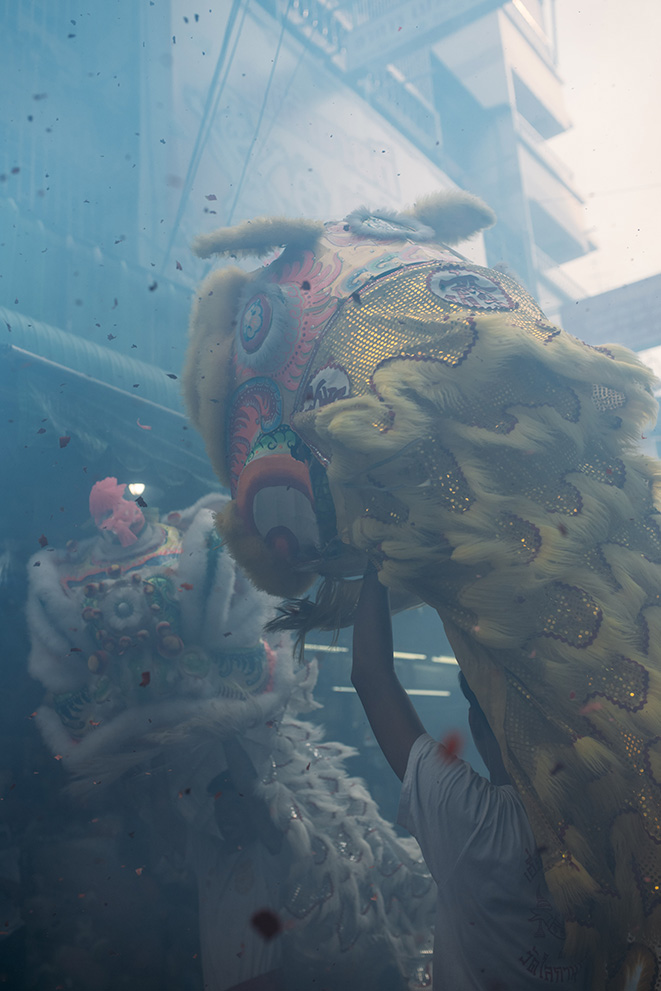
Behind the smoke screen
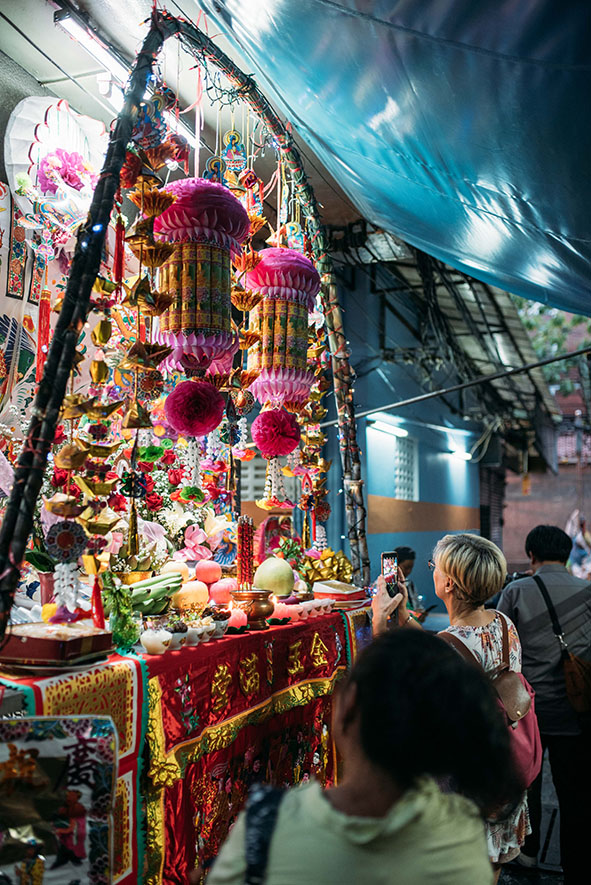
locals setting up altars to honour the goddess of the moon
Foodies would fall in love with the popular Vegetarian Festival around September/October. People across the country turn vegetarian for ten days and Chinatown organises two major events. The first being Yaowarat Road which turns into the world’s craziest vegetarian street food fest and the second event takes place in the romantic settings of the Talad Noi community. For Talad Noi the Vegetarian Festival has become the community’s cultural hallmark in its efforts to revitalise its traditions. Locals cook and sell vegetarian food along illuminated laneways while thousands of worshippers visit the area and the ancient Jao Sue Kong Shrine. The food, the crowd, giant incense, dragon dance and Chinese opera make this one of Bangkok’s most beautiful spectacles.

Me and my guests during the Charoen Chai’s Moon Festival
Festivals in Chinatown don’t only revolve around celestial beings, ancestors and spiritual cleansing but appeal to the creative side in us. Urban art events such as the Bangkok Design Week offer opportunities for state entities, designers, local businesses and communities to collaborate to draw people from all over Bangkok into the alleys of Chinatown’s. Chinatown’s events showcase creativity and design as part of a larger effort to boost Bangkok’s creative economy. As the new generation entrepreneurs trickle into areas which suffer from demographic and economic decline, local community leaders hope such efforts can help boost the well-being of their local economies.
8. The food hunter’s delight
Probably most of you have been waiting for this category – food! Indeed, exploring Bangkok through food is one of the most fun, authentic and satisfying ways to make sense of a city and Bangkok is the place to be. The entire purpose of Chinatown’s existence, appears to be solely based on shopping and eating and so prepare for a journey your tastebuds won’t easily forget.
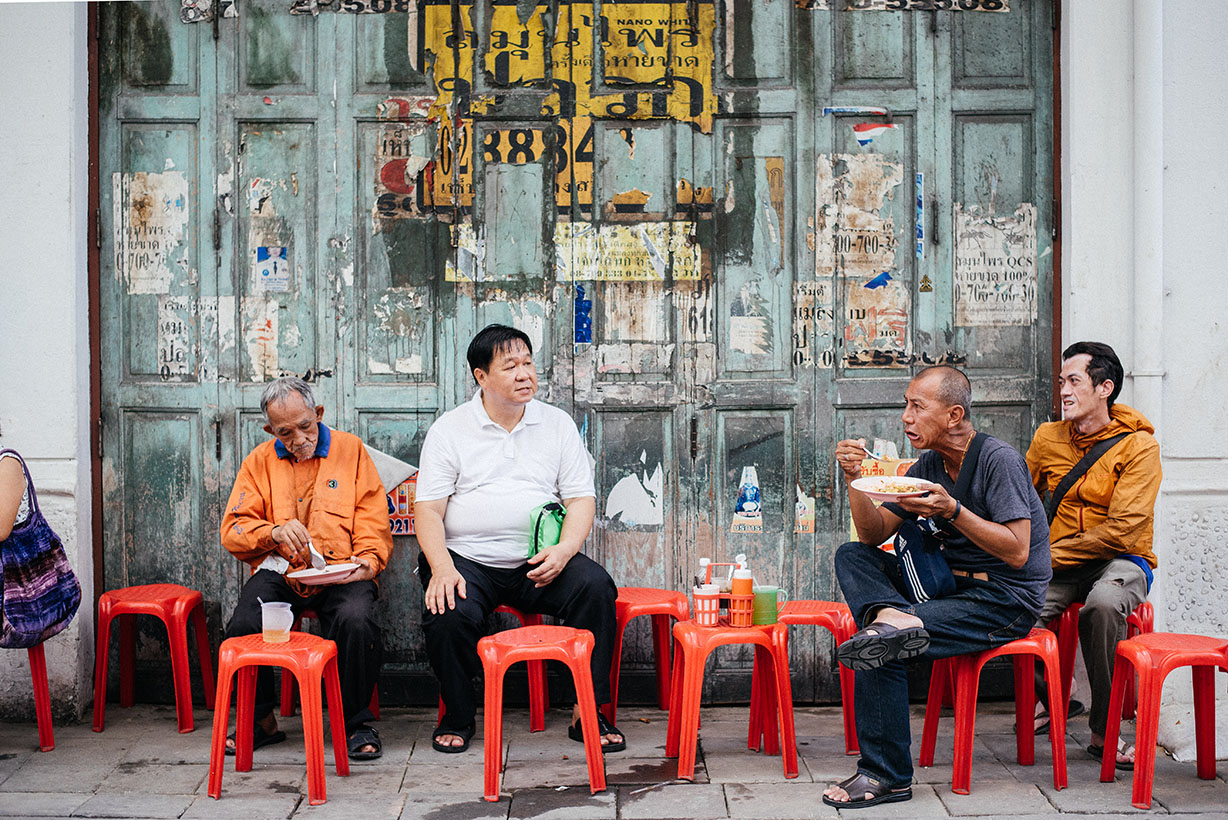
Not much needed to get our daily treats
The mother of all question here is where to begin? Bangkok has the title as the street food capital of the world and Chinatown is one of its pillars. There’s no tourist brochure without the neon-lit and street food packed scenes of Yaowarat Road. It’s the Bangkok’s epi-centre of the grilled, fried, boiled and tasty night outs where humanity converges around plastic stools and folding tables. Writing about food in Chinatown is an encyclopedia level undertaking and deserves several blog posts on their own.

Classic marinate Chinese BBQ pork
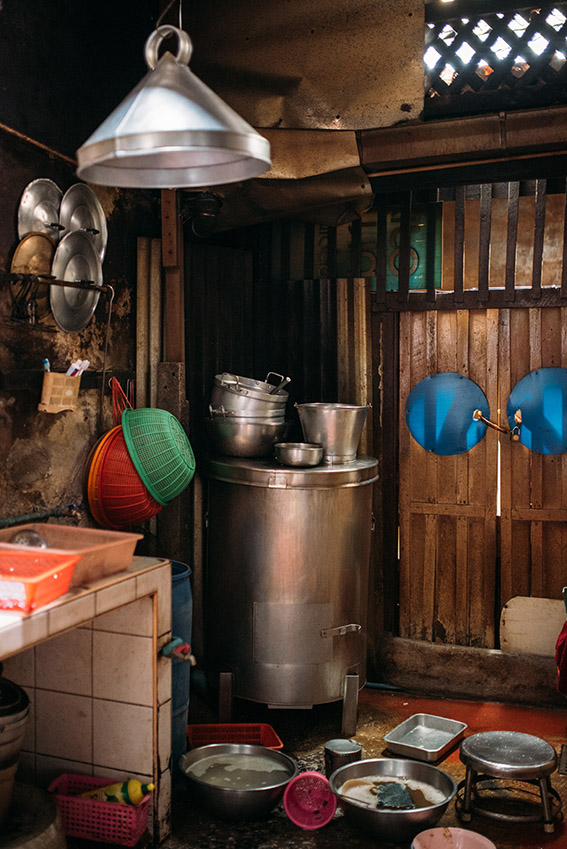
Old school kitchen of a local street vendor where the work day begins at 3:00a.m.
Yaowarat Road has been hub for food entertainment before the rise of Bangkok’s modern business and entertainment districts. Back then, theatres and the city’s best restaurants were lining Yaowarat but those days are gone. Today, street food is the first thing that comes to mind and it’s hugely popular among Thais and tourists. But to examine Chinatown’s food culture and Chinatown’s original classics then we need to go beyond the street food hub.
Not every noodle is alike
One way to distinguish the five different Chinese ethnic groups is through their cuisine. While some people might think all Chinese food is all the same, there’re regional differences from the steamed bun to the classic bowl of noodles. The Teochew Chinese are different from the Cantonese and what’s good for the Hakka may be average for Hokkien. Hence, exploring food in Chinatown is a journey into kitchens and cooking pots of Guang Dong, Chao Zhou, Hainan and Fujian.
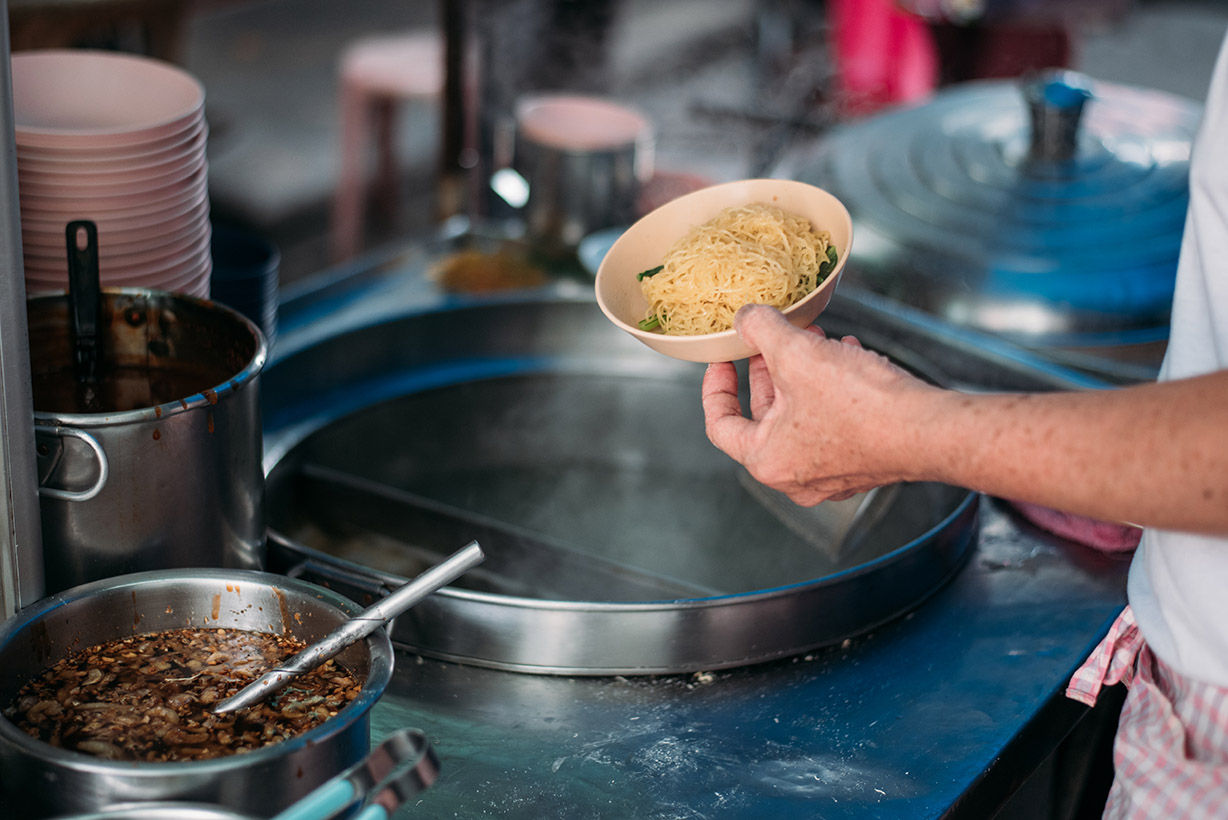
Bami Naam, Cantonese egg noodles, a classic among street food vendors. But where we can still enjoy them the traditional way, home made instead of industrial produced? This will be topic of future blogs.
The makers of food are the social institutions of neighbourhoods, conjuring up local recipes for generations. One could bemoan the decline of Yaowarat’s traditional Chinese food culture or that society’s trend toward industrial food makes us loose our sense for the real taste. Chinatown’s multi-generational food makers come to the rescue. They invite you to retake your sense for real flavours. You have to know the neighbourhoods, you have to know the locals to figure out who they are but these culinary legends that take you back to the roots and add a flavourful dimension to your sensual journey into the past. We’ll uncover them for you.
9. Explore Bangkok’s market belt
The U.S. has the Bible Belt, Bangkok has the Market Belt. The market belt is group of more than 12 large interconnected markets straddling the east bank of the river in Chinatown and the neighbouring Phra Nakhon district. They are the axis of Bangkok’s market culture, the colourful and bustling antidote to downtown’s mega-malls. Chinatown alone attracted on average more than 300,000 visitors per day (Pre-Covid) seeking everything from sea cucumbers to Hello Kitty pencil cases.

Bustling Sampeng Lane
Those markets are associated with entire neighbourhood blocks which have grown a nationwide reputation for specific products. Sampeng as Chinatown is locally known sits at the centre of the market belt. It is the most historic lane and Thailand’s largest wholesale market and operates daily from morning to 5:00p.m. Most of the goods are imported from China and Sampeng serves as redistribution centre to markets across the country. As such, people buy in bulks. The 1.5km market lane is divided into different sections with products ranging from accessories, leather, bags and backpacks, stationary, cosmetics, shoes and much more.
On the western end Sampeng connects with the Indian textile market called Pahurat. During weekends, Sampeng intersects with the Saphan Han Walking Street. Bangkok’s most chilled street food market. From the centre of Sampeng you can head northward into the belly of the dragon on Yaowarat Road. The belly of the dragon means one thing: Food! Where the markets Talad Kao (The old market), Talad Mai (the new Market) adjacent Phutarej Market and Yaowarat itself offer everything the Teochew heart desires. The three markets have existed since the 19th century and were once known as Talad Yai (The great market). It’s an essential market for meats, imported and dried goods and of the most exotic section of Chinatown’s food zone. Chefs and Chinese housewives from all over Bangkok shop for delicacies that can’t be found in your regular supermarket.

Chinatown’s Putharej market is located beneath Chinatown’s first Western apartment block.
After your nose and stomach have received their full treatment of Teochew food culture you reach the tail end of the food zone and Charoen Krung Road. This neighbourhood is home to Chinatown’s largest Daoist temples and in the centre sits the Charoen Chai community which specialises in Chinese sacred paper that worshippers buy to give offerings to Daoist deities and their ancestors. To the west we’re back in the secular world of technology with the huge Khlong Thom electronics market. What ever market you go for, don’t expect tourist-friendly kitsch. This is shopping culture from the locals for the locals.
Chinatown’s has many faces. Quiet communities can exist right beside vibrant and chaotic markets. The change of scene can be sudden but for those with a knack for action will find that Chinatown’s markets encapsulate the untamed, overstimulating urban life of Asia.
10. Leave your comfort zone, explore the playground for urban explorers
The final point I want to make is that whatever dimension of Chinatown interests you, it will require you to approach it with a blank canvas, without bias and a lots of curiosity. To explore Bangkok we often take the convenient way, being chauffeured around in a cab, dropped off at attraction A then B, etc. Bangkok’s tourist attractions, sky bars and shopping malls are all very accessible. Chinatown however is a different animal. Even though it contains attractions, it is in itself the attraction. Instead of focusing on attraction A, B and C, it is more interesting to explore the space in between A, B and C. It is here where you’ll discover the million random things, interact with people and stumble across the little, hidden pieces of city.

Explore the space in between.
Chinatown’s invites for exploration as all the things I mentioned in this article are connected through a warren of small yet safe back streets and even tinier alleys. It is here, off the main road and the comfort of our GPS and maps where the magic begins. This urban maze is a legacy of an era prior to the usage of cars. Of course, there’re some rules we must adhere as we navigate the intimacy of Chinatown’s alleys that is not take photographs of people and their homes and to be friendly and respectful at all times.
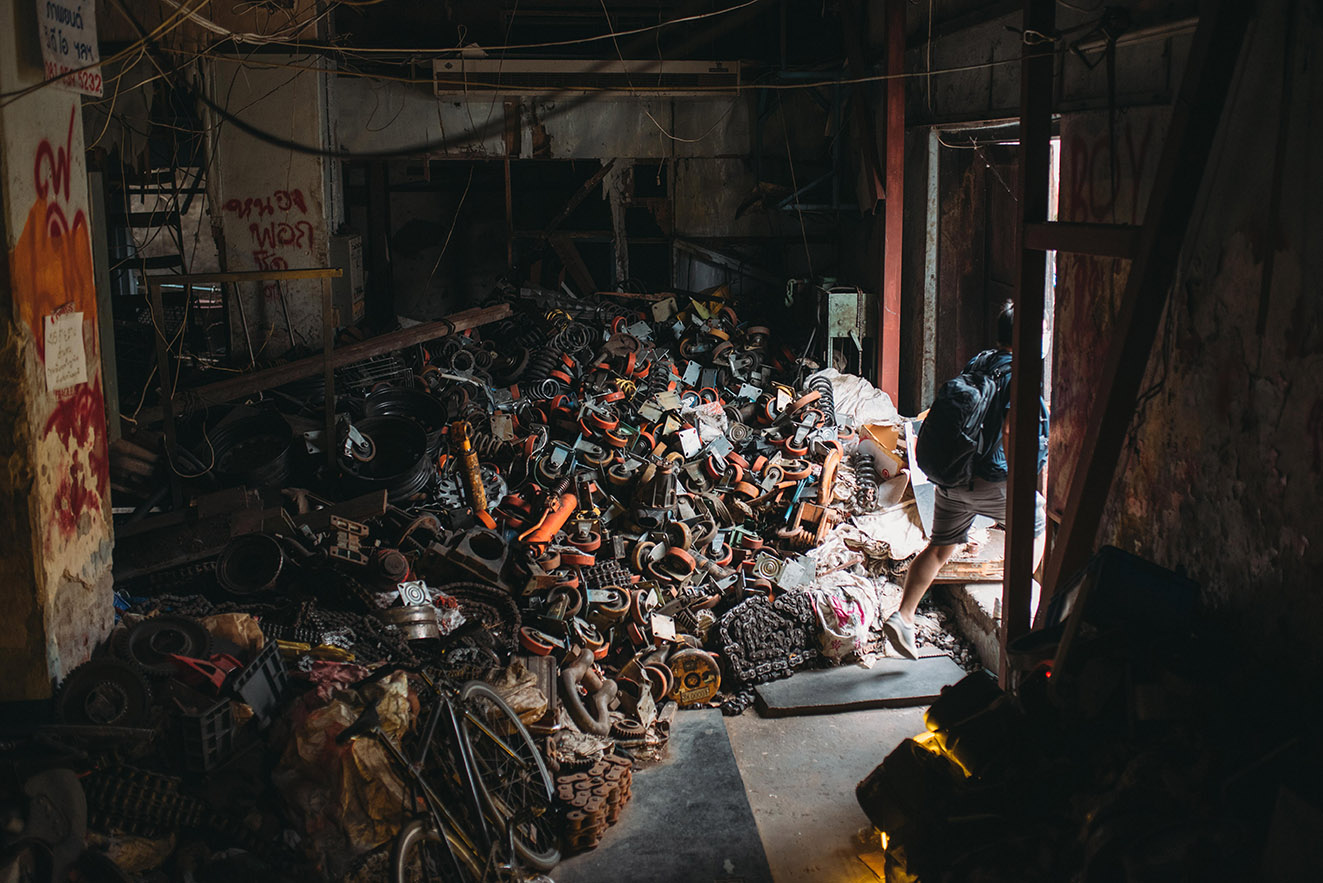
Bangkok rewards the explorer. Expect hidden jewels in unexpected places.
I hope that by sparking your curiosity and desire to explore, I will be able to help you experience the true DNA of Chinatown. To share the unseen beauty and heritage and thus support the communities, businesses and people. Maybe, travellers can contribute for relevant agencies to realise that besides the much talked about temple attractions, historic communities are also an important asset to the city.
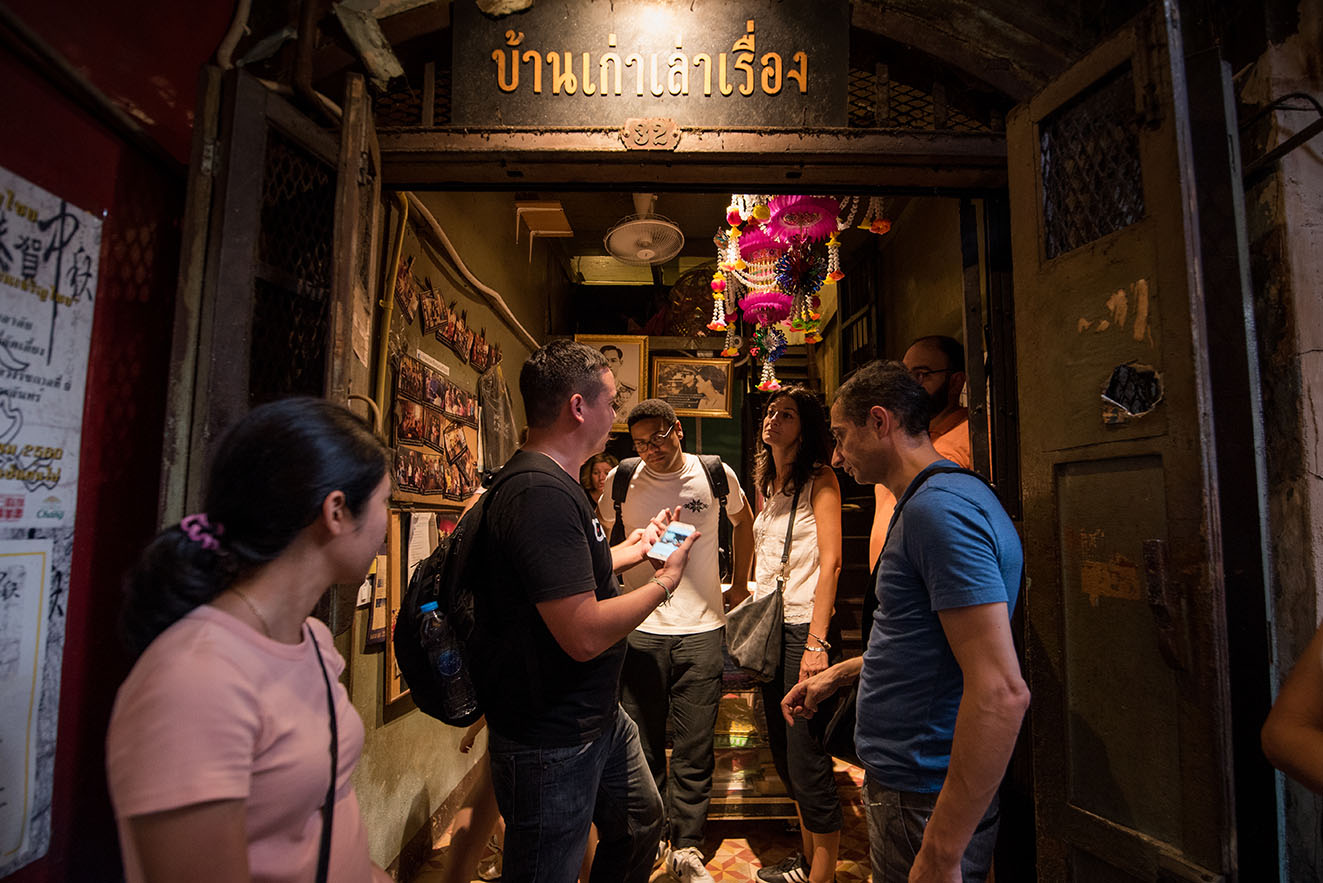
Supporting local conservation projects and local initiatives
If you liked this article, please help and share it with your friends and like-minded travellers.




